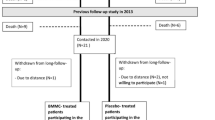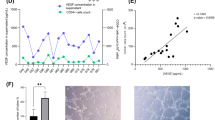Abstract
Granulocyte-colony-stimulating factor (G-CSF) seems to have direct cardioprotective effects related to mobilization of autologous bone-marrow mononuclear CD34+ cells. These properties have attracted the attention of researchers investigating new therapeutic strategies for acute myocardial infarction. The role of G-CSF in bone-marrow cell mobilization removes the need for bone-marrow aspiration and repeated invasive procedures. This factor, coupled with the fact that G-CSF can be administered by noninvasive subcutaneous injection, give this approach a potential advantage over other cell-therapy options. This article is intended to present a concise overview of the current experimental and clinical findings for G-CSF therapy after acute myocardial infarction. In particular, we discuss the conflicting findings from the front-integrated revascularization and stem cell liberation in evolving acute myocardial infarction (FIRSTLINE-AMI) and the Regenerate Vital Myocardium by Vigorous Activation of Bone Marrow Stem Cells (REVIVAL-2) studies.
Key Points
-
Granulocyte-colony-stimulating factor (G-CSF) seems to have direct cardioprotective effects
-
This growth factor can be administered by subcutaneous injection without the need for bone-marrow aspiration, manipulation of stem cells in culture, or repeated invasive procedures
-
Potential beneficial effects of G-CSF therapy after AMI reported in the FIRSTLINE-AMI study have been challenged by the REVIVAL-2 study, but the two studies had important differences in design
-
An adequately powered, double-blind, randomized, multicenter study is required, without a time delay between percutaneous coronary intervention and G-CSF application
-
Firm prognostic conclusions about G-CSF therapy after percutaneous coronary intervention for ST-segment elevation myocardial infarction cannot yet be drawn
This is a preview of subscription content, access via your institution
Access options
Subscribe to this journal
Receive 12 print issues and online access
$209.00 per year
only $17.42 per issue
Buy this article
- Purchase on Springer Link
- Instant access to full article PDF
Prices may be subject to local taxes which are calculated during checkout
Similar content being viewed by others
References
Braunwald E and Bristow MR (2000) Congestive heart failure: fifty years of progress. Circulation 102: IV14–23
Opie LH et al. (2006) Controversies in ventricular remodelling. Lancet 367: 356–367
Beltrami AP et al. (2001) Evidence that human cardiac myocytes divide after myocardial infarction. N Engl J Med 344: 1750–1757
Quaini F et al. (2002) Chimerism of the transplanted heart. N Engl J Med 346: 5–15
Deb A et al. (2003) Bone marrow-derived cardiomyocytes are present in adult human heart: A study of gender-mismatched bone marrow transplantation patients. Circulation 107: 1247–1249
Orlic D et al. (2001) Mobilized bone marrow cells repair the infarcted heart, improving function and survival. Proc Natl Acad Sci U S A 98: 10344–10349
Kocher AA et al. (2001) Neovascularization of ischemic myocardium by human bone-marrow-derived angioblasts prevents cardiomyocyte apoptosis, reduces remodeling and improves cardiac function. Nat Med 7: 430–436
Orlic D et al. (2001) Bone marrow cells regenerate infarcted myocardium. Nature 410: 701–705
Murry CE et al. (2004) Haematopoietic stem cells do not transdifferentiate into cardiac myocytes in myocardial infarcts. Nature 428: 664–668
Schachinger V et al. (2004) Transplantation of progenitor cells and regeneration enhancement in acute myocardial infarction: final one-year results of the TOPCARE-AMI Trial. J Am Coll Cardiol 44: 1690–1699
Fernandez-Aviles F et al. (2004) Experimental and clinical regenerative capability of human bone marrow cells after myocardial infarction. Circ Res 95: 742–748
Meyer GP et al. (2006) Intracoronary bone marrow cell transfer after myocardial infarction: eighteen months' follow-up data from the randomized, controlled BOOST (BOne marrOw transfer to enhance ST-elevation infarct regeneration) trial. Circulation 113: 1287–1294
Janssens S et al. (2006) Autologous bone marrow-derived stem-cell transfer in patients with ST-segment elevation myocardial infarction: double-blind, randomised controlled trial. Lancet 367: 113–121
Ince H et al. (2005) Prevention of left ventricular remodeling with G-CSF after acute myocardial infarction: Final one-year results of the FIRSTLINE-AMI trial (Front-integrated revascularization and stem cell liberation in evolving acute myocardial infarction by granulocyte colony-stimulating factor). Circulation 112 (Suppl 9): 173–180
Ince H et al. (2005) Preservation from left ventricular remodeling by front-integrated revascularization and stem cell liberation in evolving acute myocardial infarction using granulocyte-colony-stimulating factor (FIRSTLINE-AMI). Circulation 112: 3097–3106
Zohlnhofer D et al. REVIVAL-2 Investigators (2006) Stem cell mobilization by granulocyte colony-stimulating factor in patients with acute myocardial infarction: a randomized controlled trial. JAMA 295: 1003–1010
Shintani S et al. (2001) Mobilization of endothelial progenitor cells in patients with acute myocardial infarction. Circulation 103: 2776–2779
Wojakowski W et al. (2004) Mobilization of CD34/CXCR4+, CD34/CD117+, c-met+ stem cells, and mononuclear cells expressing early cardiac, muscle, and endothelial markers into peripheral blood in patients with acute myocardial infarction. Circulation 110: 3213–3220
Leone AM et al. (2005) Mobilization of bone marrow derived stem cells after myocardial infarction and left ventricular function. Eur Heart J 26: 1196–1204
Valgimigli M et al. (2004) CD34+ and endothelial progenitor cells in patients with various degrees of congestive heart failure. Circulation 110: 1209–1212
Leone AM et al. (2005) Endogenous G-CSF and CD34+ cell mobilization after acute myocardial infarction. Int J Cardiol 11: 202–208
Fujiwara T et al. (2004) Granulocyte colony-simulating factor (G-CSF) is synthesized and released from the heart in the early phase of acute myocardial infarction [abstract #1,198]. Circulation 110 (Suppl III): 250
Van de Werf F et al. Task Force on the Management of Acute Myocardial Infarction of the European Society of Cardiology (2003) Management of acute myocardial infarction in patients presenting with ST-segment elevation. Eur Heart J 24: 28–66
Kang HJ et al. (2004) Effects of intracoronary infusion of peripheral blood stem-cells mobilised with granulocyte-colony stimulating factor on left ventricular systolic function and restenosis after coronary stenting in myocardial infarction: the MAGIC cell randomised clinical trial. Lancet 363: 751–756
Valgimigli M et al. (2005) Use of granulocyte-colony stimulating factor during acute myocardial infarction to enhance bone marrow stem cell mobilization in humans: clinical and angiographic safety profile. Eur Heart J 26: 1838–1845
Suarez de Lezo J et al. (2005) Effects of stem-cell mobilization with recombinant human granulocyte colony stimulating factor in patients with percutaneously revascularized acute anterior myocardial infarction. Rev Esp Cardiol 58: 238–240
Kuethe F et al. (2005) Treatment with granulocyte colony–stimulating factor for mobilization of bone marrow cells in patients with acute myocardial infarction. Am Heart J 150: 115
Bayes-Genis A et al. (2002) Macrophages, myofibroblasts and neointimal hyperplasia after coronary artery injury and repair. Atherosclerosis 163: 89–98
Fukuda D et al. (2004) Circulating monocytes and in-stent neointima after coronary stent implantation. J Am Coll Cardiol 43: 18–23
Kong D et al. (2004) Cytokine-induced mobilization of circulating endothelial progenitor cells enhances repair of injured arteries. Circulation 110: 2039–2046
Takamiya M et al. (2006) Granulocyte Colony-Stimulating Factor–Mobilized Circulating c-Kit+/Flk-1+ Progenitor Cells Regenerate Endothelium and Inhibit Neointimal Hyperplasia After Vascular Injury. Arterioscler Thromb Vasc Biol 26: 751–757
Harada M et al. (2005) G-CSF prevents cardiac remodeling after myocardial infarction by activating the Jak-Stat pathway in cardiomyocytes. Nat Med 11: 305–311
Lehrke S et al. (2006) Aging impairs the beneficial effect of granulocyte colony-stimulating factor and stem cell factor on post-myocardial infarction remodeling. Circ Res 99: 553–560
Author information
Authors and Affiliations
Corresponding author
Ethics declarations
Competing interests
The authors declare no competing financial interests.
Rights and permissions
About this article
Cite this article
Ince, H., Nienaber, C. Granulocyte-colony-stimulating factor in acute myocardial infarction: future perspectives after FIRSTLINE-AMI and REVIVAL-2. Nat Rev Cardiol 4 (Suppl 1), S114–S118 (2007). https://doi.org/10.1038/ncpcardio0731
Received:
Accepted:
Issue Date:
DOI: https://doi.org/10.1038/ncpcardio0731
This article is cited by
-
Bone marrow-derived mesenchymal stem cells migrate to healthy and damaged salivary glands following stem cell infusion
International Journal of Oral Science (2014)
-
Zellbasierte Strategien für die Speicheldrüsenregeneration
HNO (2008)



